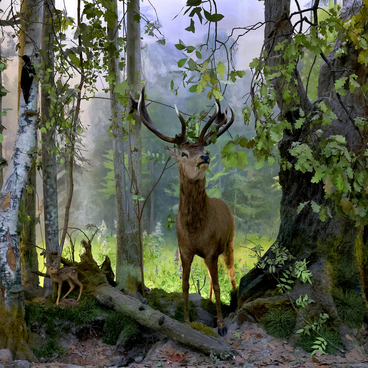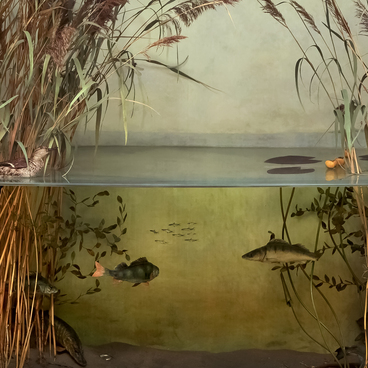The museum’s diorama “River Floodplain and Bog” displays a section of a forested river bank in the Polessky district of the Kaliningrad region, in the territory of beavers’ habitat. It shows the forest in summer time.
Quiet forest rivers with softwood trees: aspen, birch, willow, alder are preferred by the river beaver, which was brought to the region from the Belorussian SSR in 1955. The animals have successfully settled in the region.
Beavers are very active animals, they have a significant impact on the environment: in places where they build dams, stagnant water floods gullies, the water table rises and the area becomes waterlogged.
These animals are in the foreground of the diorama. They are engaged in the preparation of wood fodder; next to it is a beaver lodge. Its entrance is not visible to the museum visitors: the reason is that beavers always place it below the water level to make it difficult for predators to get in. To build a dam beavers gnaw the trunks of young trees. The frame of the dam made of trunks and branches is fastened with clay and silt. The largest known beaver dam was 850 meters long.
Lowland bogs are located in low-lying parts of the relief and are formed in river valleys when lakes are overgrown. They are supplied by precipitation, surface and ground water. Usually grasses or green mosses grow in such places, some bogs are covered with forest, and birch and alder trees predominate. High (peat) bogs are those that have lost contact with groundwater because they have accumulated a lot of peat. Water enters bogs only with precipitation.
Part of the territory of the Kaliningrad region is occupied by both high and lowland bogs. Their area is steadily decreasing due to reclamation works. The idea of protection of peat bogs has recently become more and more recognized. The Bolshoye Mokhovoye bog and the Tselau bog are among such bogs. The ecosystem of the latter is of paramount importance to preserve the natural resources of the region.
Tselau is one of the
last naturally preserved bogs in Central Europe. Its territory is inhabited by
rare and endangered species of animals and plants. The peat layer of the bog
contains more than 30 million cubic meters of clear water. The Prokhladnaya
river, where spawning grounds for salmon and bull trout are preserved,
originates from it.


